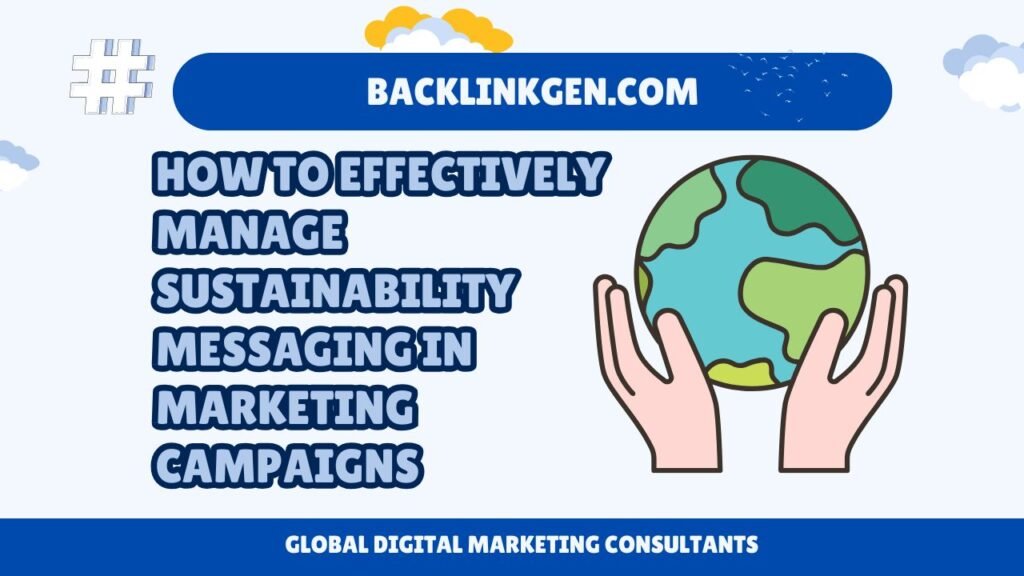By Amit – Senior Digital Marketing Strategist,
In 2025, sustainability is no longer just a buzzword — it’s a core expectation. Whether you’re a global brand or a local business, customers want to know that your values align with their own. From environmental responsibility to ethical sourcing and social transparency, sustainability has become a defining factor in brand trust.
As someone who’s been managing digital campaigns for over 15 years — across education, SaaS, and tech sectors — I’ve noticed a consistent pattern: brands that communicate sustainability authentically not only stand out but build long-term loyalty.
However, managing sustainability messaging effectively is not as simple as adding “eco-friendly” to your tagline. It requires strategy, consistency, and proof. In this blog, I’ll share how marketers can craft sustainable brand messages that connect emotionally, ethically, and commercially.
1. Start with Authenticity — Not Buzzwords
The foundation of any sustainability campaign is authenticity. Consumers today are extremely aware of greenwashing — the practice of exaggerating or falsely claiming sustainability efforts.
If your campaign focuses on sustainability, your messaging must reflect real actions. For example:
- If your brand uses recyclable materials, highlight your supply chain process, not just the packaging.
- If your school promotes sustainability, showcase student-led environmental projects instead of generic “Go Green” posters.
Authenticity begins by identifying what you’re actually doing for sustainability and building stories around those efforts.
“Transparency builds trust faster than any slogan ever will.”
2. Define What Sustainability Means for Your Brand
Sustainability isn’t one-size-fits-all. For a CRM SaaS company, sustainability may mean reducing carbon footprints through remote operations or powering servers with renewable energy.
For schools and colleges, it might mean eco-curriculums, plastic-free campuses, or energy-efficient infrastructure.
Before crafting messages, ask:
- What aspects of sustainability are most relevant to our brand?
- How does our audience define sustainable behavior?
- What real-world impact can we demonstrate?
By answering these questions, you can align your sustainability messaging with both brand values and customer expectations.
3. Integrate Sustainability into the Core Brand Story
Sustainability should never feel like an afterthought. It should be woven into your brand narrative, not treated as a seasonal campaign.
For instance, when we manage digital branding for educational institutions, we integrate sustainability into the school’s vision statement, web content, and social storytelling. This creates continuity and reinforces values consistently over time.
Practical ways to integrate sustainability messaging:
- Include sustainability commitments in your About Us section.
- Share progress updates in newsletters and social posts.
- Use visuals (infographics, short videos) to make impact stories relatable.
The goal is to make sustainability part of your identity, not a marketing angle.
4. Use Data and Proof Points
The modern audience doesn’t just want to hear about your sustainability — they want to see it.
Back up every claim with verifiable data. Whether it’s energy savings, waste reduction, or community impact, measurable proof enhances credibility.
Examples of proof-driven messaging:
- “Our CRM SaaS servers run on 100% renewable energy.”
- “This college reduced paper usage by 60% through digital assignments.”
- “We saved 3 tons of plastic annually by switching to biodegradable packaging.”
When managing SEO campaigns for clients, we often embed these stats into landing pages and case studies — because Google rewards credible, data-backed content just as much as audiences do.
5. Leverage Storytelling — People Love Real Impact
Numbers show progress, but stories create emotional connection.
Tell stories about the people behind your sustainability efforts:
- The IT engineer who led the shift to solar-powered servers.
- The students who started a recycling initiative.
- The supplier who adopted ethical sourcing practices.
Use formats like video testimonials, reels, blogs, and LinkedIn posts. On social media, especially platforms like Instagram and Threads, visual storytelling performs exceptionally well when combined with personal narratives and real imagery.
Storytelling turns sustainability from a corporate goal into a human story.
6. Train Your Teams for Consistent Messaging
Consistency is critical. Every person representing your brand — from marketing to sales to customer support — should understand and reflect the same sustainability narrative.
As marketers, we often focus on external communication and forget internal alignment. That’s where many campaigns fail.
At Kanity.in, when we work with schools and SaaS clients, we ensure that sustainability messaging is embedded in:
- Staff training materials
- Website copy
- Social media guidelines
- Ad creatives and email templates
When everyone speaks the same sustainability language, it reinforces brand authenticity and eliminates confusion.
7. Avoid Overclaiming — Greenwashing is a Reputational Risk
Nothing damages credibility faster than overstating your sustainability efforts. Consumers have become skeptical — and rightfully so.
Avoid vague terms like “eco-friendly,” “green,” or “ethical” without context. Instead, use specific language backed by facts.
Bad Example: “We’re a green company committed to the planet.”
Better Example: “We’ve reduced packaging waste by 40% using recycled materials and biodegradable tape.”
When we consult for digital campaigns, I always recommend that brands perform a “sustainability audit” — verifying every claim before publishing. The best sustainability campaigns don’t exaggerate; they educate.
8. Choose the Right Platforms for Sustainability Messaging
Different platforms require different tones and content formats.
- LinkedIn: Perfect for publishing sustainability reports, CSR updates, and thought leadership articles.
- Instagram & Threads: Great for visual storytelling — before-and-after transformations, short sustainability facts, or staff initiatives.
- Facebook: Works well for community engagement and public awareness posts.
- YouTube & Reels: Ideal for short educational or behind-the-scenes videos.
For my educational clients, we often run video-led campaigns that showcase campus sustainability programs — and these generate more engagement than traditional text posts.
The key is to meet audiences where they already care, using the right tone and visual style for each platform.
9. Collaborate with Influencers and Communities
Partnering with eco-conscious influencers or sustainability advocates can amplify your message. These collaborations provide both authenticity and reach.
However, choose influencers carefully — they should genuinely believe in your cause. A mismatch between influencer behavior and your sustainability values can backfire.
You can also engage local communities or NGOs. For example, schools can collaborate with recycling programs, while SaaS firms can support e-waste awareness campaigns.
Collaborations build trust because they demonstrate collective responsibility rather than self-promotion.
10. Measure Impact and Refine Over Time
Sustainability marketing is an ongoing process — not a one-time announcement.
To keep improving, you need to measure outcomes:
- Website traffic and engagement on sustainability pages
- Mentions of your brand in sustainability-related conversations
- Growth in brand sentiment and trust metrics
- Conversion lift among eco-conscious consumers
Use tools like Google Analytics 4, Brandwatch, or Hootsuite Insights to track engagement and adjust your strategy.
Over time, focus less on vanity metrics (likes, impressions) and more on impact metrics — how your message drives awareness, behavior, and advocacy.
The Future of Sustainable Marketing
As environmental and social awareness grows globally, sustainability will become central to brand identity — not a separate initiative.
In the coming years, we’ll see brands integrating AI-driven sustainability tracking, carbon-neutral ad campaigns, and green analytics dashboards to ensure transparency at every level.
At Kanity.in, we’ve already started helping clients align their digital campaigns with sustainability principles — from using eco-hosting solutions to optimizing ad spend efficiency.
The truth is: sustainability and marketing are no longer two separate disciplines. The most successful brands will merge the two — using digital tools to scale ethical impact.
Final Thoughts
Managing sustainability messaging effectively isn’t about perfection — it’s about progress, honesty, and accountability.
As Amit, my philosophy is simple:
“Your sustainability message is not what you say — it’s what your brand consistently proves.”
Start small, stay consistent, and let real impact lead your narrative. Because in today’s digital era, authentic sustainability is not just good ethics — it’s smart marketing.

